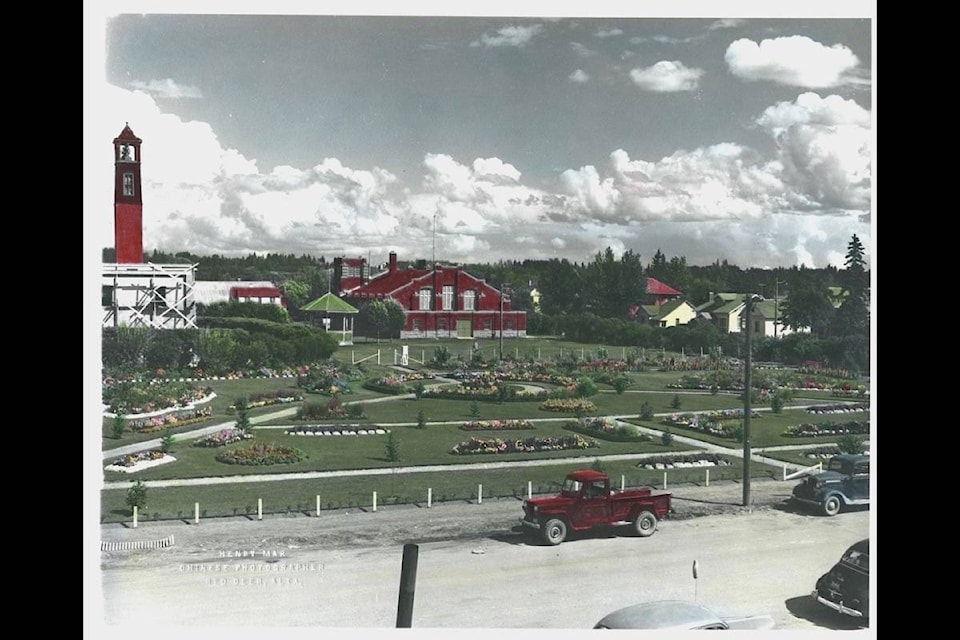One of the crown jewels of Red Deer is City Hall Park, the magnificent ornament floral gardens on the west side of City Hall.
This year marks the 70th anniversary of this very popular community feature, which draws thousands of visitors every year.
The concept of a municipal public square actually goes back to the turn of the last century. When Red Deer was incorporated as a town in June 1901, there was a strong belief that the community needed a large open public space, in the centre of the town, that could be used for public gatherings, farmers’ markets, sporting events and such cultural gatherings as band concerts.
Consequently, a plan was submitted to the town’s ratepayers to authorize the spending of $4,500 to purchase a whole city block of land, on the southside of Ross Street and east of MacKenzie (49th) Avenue.
Although the amount was nearly twice the town’s annual budget, the voters saw the wisdom of this concept. The authorizing bylaw was approved overwhelmingly.
Unfortunately, the plan hit a number of unexpected snags. After the sudden death of the young lawyer handling all the legal paperwork, a number of the land transfer documents could not be located.
One of the landowners then decided to try and block the sale of their property. A prolonged legal dispute ensued.
In 1912, the courts finally ruled in the town’s favour. The following year, when Red Deer was incorporated as a city, the new city council hired C.A. Julian Sharman, a local architect, to draw up an elaborate civic centre plan.
Unfortunately, a sharp economic downturn followed by the outbreak of the First World War in August 1914 meant that most of Sharman’s plans were never implemented.
Instead, the city square was levelled and seeded to grass. Controversy erupted when some city councillors objected to the $1,000 cost of the project, which included having city engineer Robert Dawe remove 1,100 loads of dirt from the site.
For the next couple of decades, the civic square was largely used as a recreation area, although large public meetings were also held there. Ball games were played in the spring and summer.
In the winter, the south area of the square was turned into an outdoor skating rink.
In 1924, the Rotary Club installed a playground on the east side. In 1943, the Elks Club built a paddling pool on the northeast corner of the block.
Finally, in 1949, parks superintendent Hugh Gilchrist proposed the creation of a large ornamental park and garden on the west side of City Hall.
Several city councillors objected to the plan because they felt the $1,500 cost was too extravagant. The mayor objected because he felt the site was better suited for the existing sports and recreational activities, rather than to attempt to turn the area into “a place of beauty.”
When the plan was put to a vote, city council was split down the middle. One councillor stated that he was “undecided as to the best time to launch” the development of a new city park. However, he finally decided to vote in favour in order to break the tie.
Thus, city council decided to create an ornamental City Hall Park by a margin of only one vote.
Gilchrist laid out the new park in a spoke pattern, with the central hub set as a proposed site for the city’s cenotaph (war memorial).
The basics of the new park were put into place in the spring and summer of 1950. However, in 1951, the plan to move the cenotaph was defeated by the voters in a plebiscite. The cenotaph was to remain on its original site on Ross Street, west of 49th Avenue.
There have been many changes over the years. After the construction of the new City Hall in 1964, the park was extended to include the site of the old building.
In 1967, a parking lot on the square, which had been used by city employees, was turned into a site for the new Centennial Library as well as a further extension of the park.
Today, City Hall Park is one of the most beloved features of the community. And every year, the dedicated members of the city parks department make sure that the park remains as beautiful and well kept as ever.
Red Deer historian Michael Dawe’s column appears Wednesdays.
